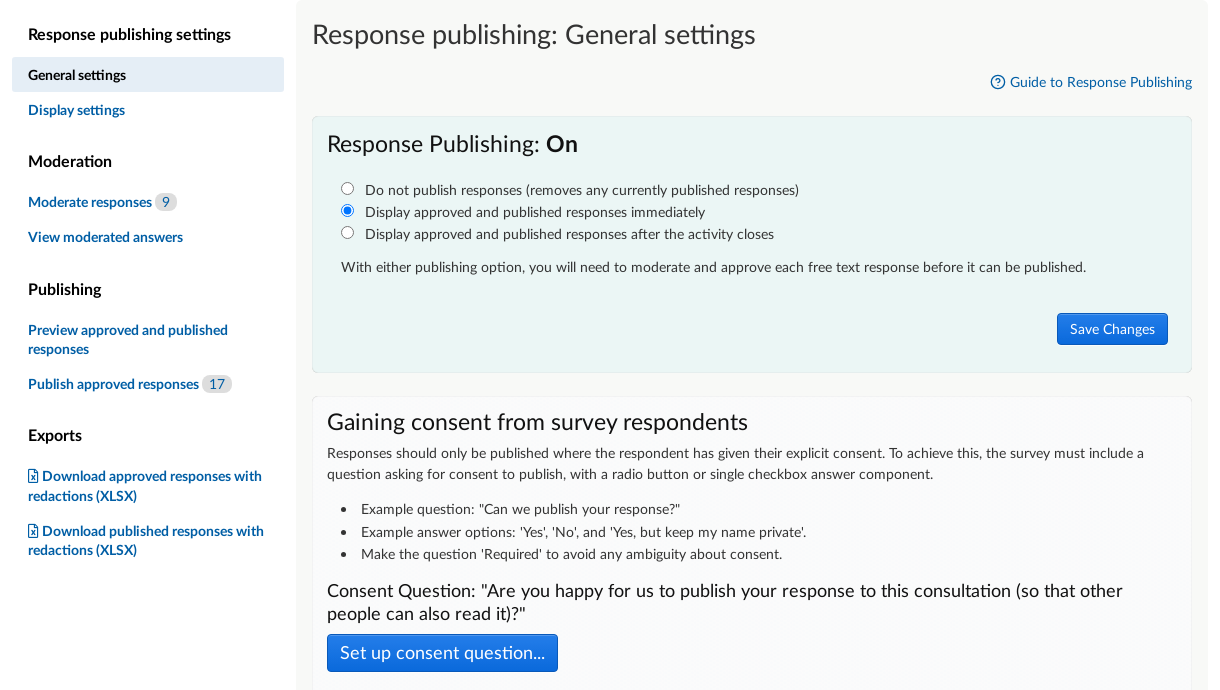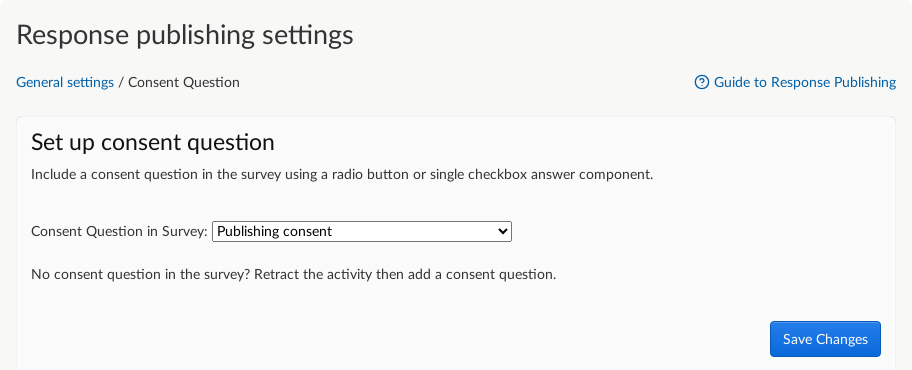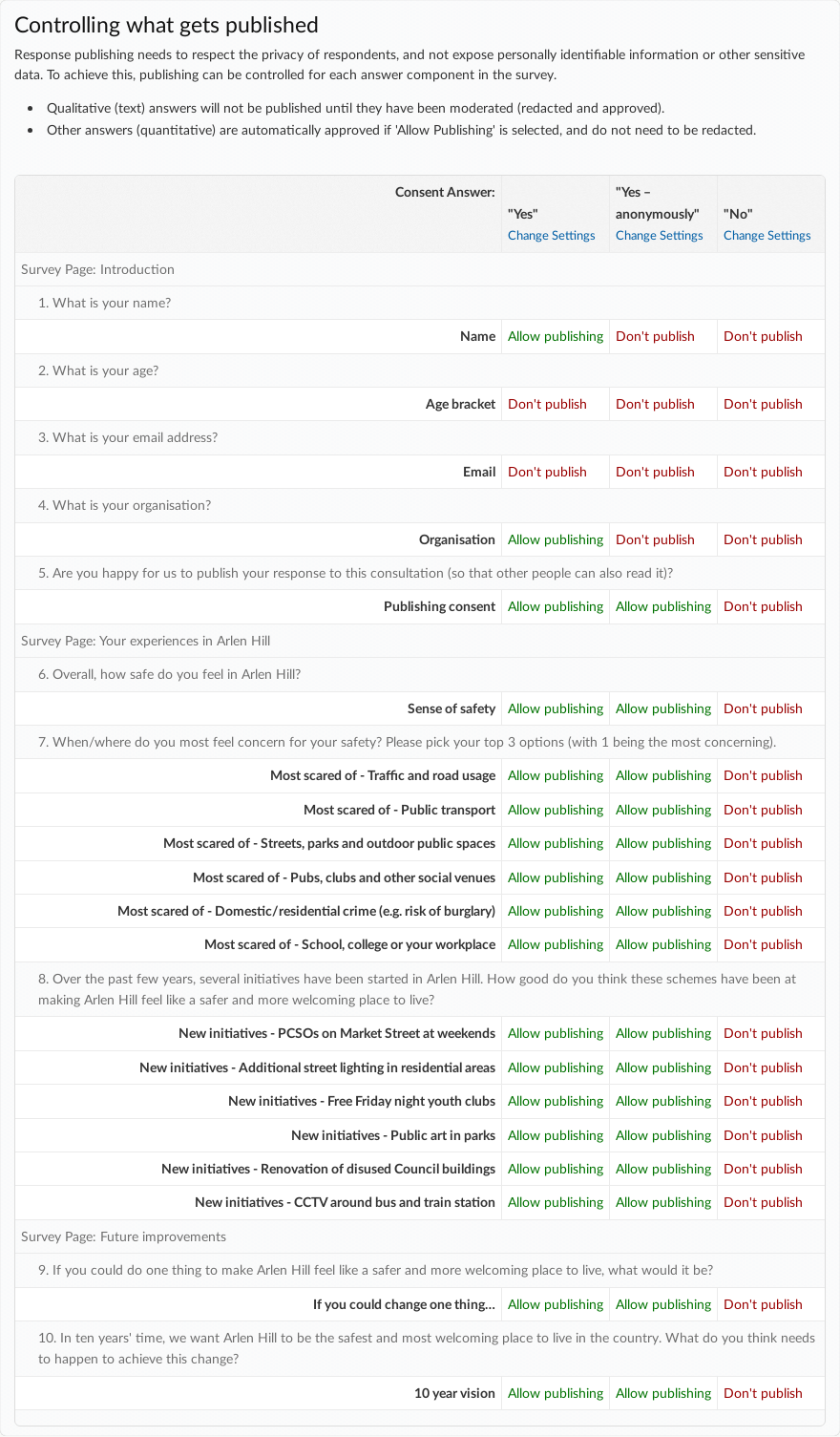Response publishing for Geospatial activities
This article is for Citizen Space Geospatial. Please speak to your customer success manager if you are interested in learning more about it.
In this article we’ll discuss:
- What is response publishing?
- How does response publishing differ for geospatial?
- Setting up response publishing for geospatial activities
What is response publishing?
Response publishing is a feature in Citizen Space which allows your organisation to publish submissions from respondents. It is a great way to be transparent about your consultations and activities - citizens can see what other people have said, and responses can be anonymous or published with identifying information if consent is given.
Here are some more useful articles on response publishing:
How does response publishing differ for geospatial?
There are 2 main ways that response publishing differs for geospatial activities:
- Individual published responses will now show a map for any published map questions e.g. where someone has drawn a point on a map.
- The Published Responses page now can show a map view where all the published aggregated responses for one of the mapping questions are shown.

Setting up response publishing for geospatial activities
The first thing to do when setting up a geospatial activity with response publishing is to create the activity and add a consent question. Once that is done you can crack on with deciding which questions will be published — this can be done in 5 easy steps!
Step 1: Turn on response publishing
To turn on publishing for a particular activity, once your consent question has been set up, go to Responses in the activity's navigation bar and select Response Publishing in the dropdown menu:

Then toggle the radio buttons to switch on response publishing:

When setting up response publishing you have the option to either:
- Display published responses immediately which enables approved responses to be publicly visible while the activity is still open and collecting responses. Please note that the response must still be moderated, approved and published by the administrator before it can be published.
- Display published responses after the activity closes which enables approved responses to be publicly visible after the activity is closed.
You may turn off response publishing by selecting Do not publish responses. Responses that may have been previously published will no longer be visible to the public.
It is worth noting that both options to publish require the submission to be moderated and approved by the administrator before the response is published.
The option which is most suitable will depend on your requirements, and whether you want people to be able to see other respondents' submissions before submitting their own (which may influence what they submit).
Choosing 'Display published responses immediately' might be preferable if you're using Citizen Space to run ongoing surveys or want some sort of social proof of other responses. For example, an activity to gauge interest in electric vehicle charging points.
If there's no specific closing date, it's useful for the administrator to be able to publish responses while the activity is still open.
Step 2: Set the consent question
The consent question must have a radio button or single checkbox answer component.
Once you have created your consent question and turned response publishing on, you'll see the Set Up Consent Question button.
Within the dropdown list you will see all of the questions in your activity which have a radio button or single checkbox answer component. Select the question you added as the consent question.
This list will show both the question and reporting field headings you entered when setting up your survey — you need to select the reporting field heading. In the example below, the reporting field heading for the consent question is 'Response publishing'.

If you have not yet included a consent question, add one to your survey and return to set up the question following the above steps.
Step 3: Set what questions get published
The default setting for all questions when you first set up the response publishing on each activity is Don't publish.
To allow publishing of questions, on the 'Set up Response Publishing' page, go to the table where you can set the publishing settings for each individual answer component.
The table lists all the reporting field headings of answer components which can be published, including mapping components.
At the top of this table you will see Consent Answer and the answers to the consent question.
You must manually change the publishing settings for each answer component. Remember to reflect what you've outlined in the consent question.
Under Consent Answer, you can see the answers to the consent question.

How to set questions to be published
To change if an answer can be published or not, select Change Settings under each answer. You can then toggle between 'Don't publish' or 'Allow publishing' depending on the answer component.
Top user tip: If you've got tons of publishing permissions to change, use 'TAB and the down arrow ↓' - it is way faster than selecting each one individually!
You may wish to have an option to the consent radio question which allows a user to opt-out of publishing completely, so the Don't Publish Any column for that respondent would be selected.

Select the Save Changes button, and return to the main table via the Response Publishing Settings link at the top of the table.
And now you're all set for Response Publishing!
It is worth bearing in mind how qualitative and quantitative answer components work with response publishing:
- Qualitative (free text) responses which are allowed to be published must be moderated and approved before eventually being published.
- Quantitative (multiple choice, check box, radio buttons) are automatically approved and do not require redaction.
- Geographic responses (respondents drawing on a map) are automatically approved and do not require redaction.
- File uploads (e.g. if you gave respondents the opportunity to provide supporting documents via a file upload component) must also be moderated but via a different moderation process - you can read more here.
Once your activity is open and responses have been submitted, you may begin the process of moderation and redaction. Please read this article on moderation and redaction to guide you through this process.
Step 4: Choose which mapping question is shown
If your survey has one or more publishable mapping components, then published responses can also be shown on a map.
On the Response Publishing Settings page, select 'Choose Mapping Component' button.

This will give you the option to select which of the mapping components from the survey you would like to use for the map view of published responses. This map will inherit the starting view and layers that were set in the question.
Step 5: Customise how the published responses appear to the public
Finally you must make sure that the responses appear in a clear and sensible way to the public. You can customise various parts of this page for each activity:
- The introductory text at the top of the page (make sure you include details on what question the map is showing).
- The excerpts displayed on the tile for each published response.
- The filters that visitors to your site can use to narrow down and search for responses.
.png)